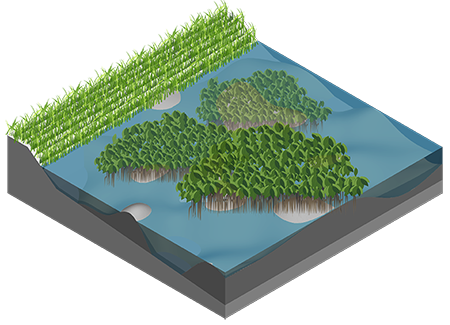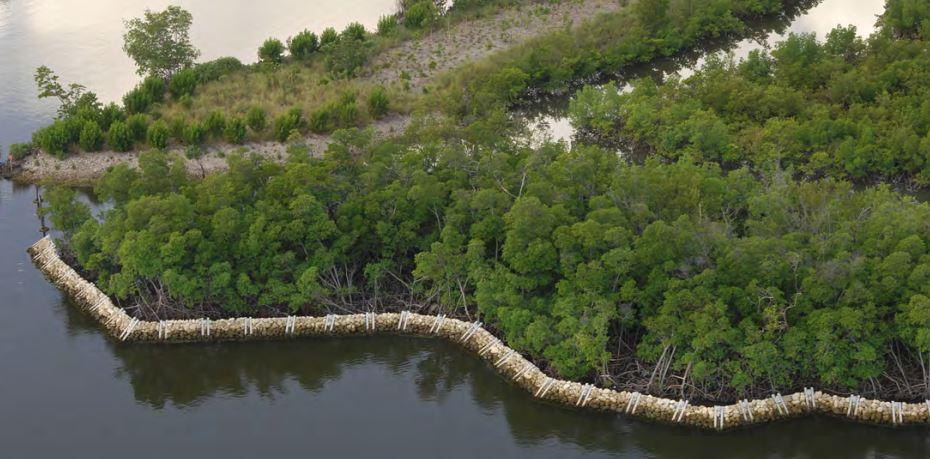Mangroves
Mangroves are a type of coastal or estuarine wetland, characterized by the presence of salt adapted trees and shrubs, that grows along the coast in tropical or subtropical latitudes throughout the world. Many mangrove forests can be recognized by their dense tangle of prop roots that make the trees appear to be standing on stilts above the water. These root systems often serve to both support the trees and, in some species, provide a means of getting air to the roots while they are submerged during higher tidal events.
While there are as many as 80 species of mangrove trees globally, only four species – red, black, white, and buttonwood mangroves – are found in the continental United States, mainly in southern Florida with some stretches throughout the Gulf Coast. One of the largest mangrove forests in the world is found on the southwest coast of Florida.
Mangroves provide an important habitat to a wide array of marine and terrestrial species. The quieter, more protected waters found among mangrove roots provide breeding, foraging, and spawning areas for commercially and recreationally important fisheries. Numerous bird species make their nests in the upper branches of mangrove trees and hunt and fish within the confines of the mangrove forest.

Hazard Mitigation
Mangroves are among the most effective natural forms of coastal protection found in the world. Their complex root systems and physical structure are able to absorb wave energy and reduce wave heights from storm surge. Studies suggest wave height can be reduced by 13 to 66 percent over a 100-meter-wide mangrove belt, while wave height can be reduced by 50 to 100 percent over a 500-meter-wide mangrove belt. The vegetation found in a mangrove also reduces wind speeds over the water surface, lessening the likelihood of waves increasing in height within mangrove areas. Wave height reduction within a mangrove forest depends on the width of the forest, mangrove tree morphology, water depth, topography, and wave height.
The same physical structure that reduces wave energy also serves to settle sediment out of the water column. The combination of lessened wave energy and increased sedimentation serves to reduce coastal erosion and, in some cases, can even allow mangroves to keep pace with sea level rise through accumulation of sediment and vertical growth over time, providing ongoing protection even as sea levels increase.
Threats
Coastal development is the single greatest threat to mangroves in the United States. In addition to direct impacts to mangrove forests from urbanizing coastal areas, such as clearing and filling wetland areas, coastal development also brings with it change to the tidal cycle through human driven water management practices, such as mosquito ditching and dredging of coastal waterways. Alterations to the flow of freshwater into mangrove systems and to the tidal regime have resulted in increased salinity and impacts to the overall health of mangrove forests in the United States. The combination of these practices, as well as shoreline hardening practices and other coastal management efforts, have resulted in considerable losses of mangrove swamps.
Changes to the climate are also having significant impacts on mangroves. Increased sea levels have the potential to drown mangrove forests when there is not enough sediment available for mangroves to grow at the same pace vertically. Increased water temperatures are also having an impact on mangroves, actually resulting in the apparent beginnings of northward migration of mangrove species as warmer waters are creating new areas where mangroves may survive.

Co-Benefits
In addition to reducing the impacts of storm events and limiting erosion, mangroves offer a wide array of benefits. Mangroves provide habitat for an enormous number of fish and bird species, creating opportunities for recreational fishing and bird watching as well as other outdoor tourism activities such as kayaking and wildlife viewing. In Florida alone, the bone fish, tarpon and red snapper recreational fisheries – all mangrove reliant species – are estimated to produce as much as $1 billion in annual value.
Mangroves also play an important role in carbon sequestration and water purification. Mangroves are capable of effectively trapping carbon in their soils, creating opportunities for much longer term carbon storage than other habitats that store carbon solely in the form of biomass. Additionally, both through accumulation of sediment and the settling out of pollutants, mangroves can perform a vital role in improving coastal water quality, providing an important benefit not only to human communities but also to seagrasses and coral reefs that may be located just offshore of mangroves.
Additional Resources
The University of Cambridge, the Nature Conservancy, and Wetlands International have published a guide for policy makers and coastal managers focused on the coastal protection benefits of mangroves. The guide contains information on how mangroves can help protect coastlines as well as what benefits they provide and how restoration and protection efforts can get underway.
The US Fish and Wildlife Service has extensive information on mangroves in the Southern Florida.
Mangrove information from the state of Louisiana.

